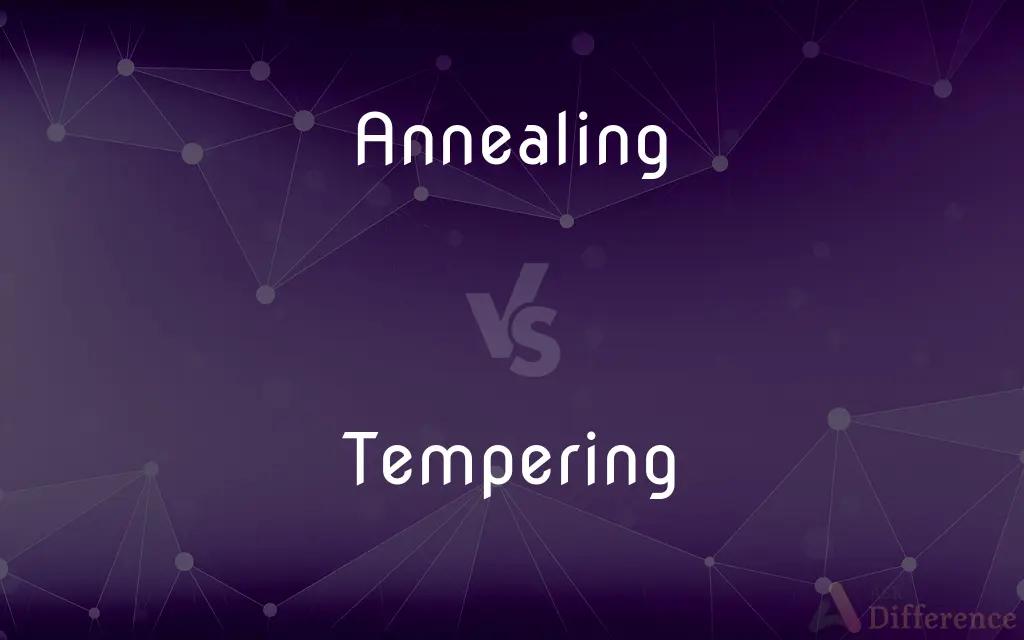Annealing vs. Tempering — What's the Difference?
Edited by Tayyaba Rehman — By Fiza Rafique — Published on December 10, 2023
Annealing softens metals and removes internal stresses by heating and slow cooling; Tempering reduces brittleness in hardened metals by heating to a specific temperature and controlled cooling.

Difference Between Annealing and Tempering
Table of Contents
ADVERTISEMENT
Key Differences
Annealing is a heat treatment process where metals are heated to a specific temperature and then allowed to cool slowly, usually in the furnace itself. This process is aimed at softening the metal, enhancing its ductility, and reducing its internal stresses. Tempering, on the other hand, is a method applied to metals that have been hardened, aiming to reduce their brittleness.
When a metal undergoes Annealing, its microstructure undergoes changes that lead to improved workability, making it easier to shape or weld. Conversely, Tempering fine-tunes the properties of the previously hardened metal, providing a balance between hardness and toughness.
While Annealing typically involves heating the metal to a high temperature and then allowing it to cool very slowly, Tempering involves heating the already hardened metal to a temperature below its hardening temperature and then cooling it at a desired rate.
Annealing can sometimes result in a large grain size in the metal's structure due to the prolonged exposure to high temperature. Tempering, conversely, modifies the size and distribution of these grains to enhance certain mechanical properties without drastically altering the grain size.
In essence, while Annealing focuses on softening the metal and making it more workable, Tempering aims to achieve a balance in the metal's properties after hardening, ensuring it's not too brittle for practical applications.
ADVERTISEMENT
Comparison Chart
Purpose
Softens metals and reduces internal stresses.
Reduces brittleness in previously hardened metals.
Heating
Heated to a high temperature.
Heated to a temperature below its hardening temperature.
Cooling
Slow cooling, often in the furnace.
Controlled cooling at a specific rate.
Effect on Microstructure
Can result in larger grain size.
Modifies grain size/distribution without drastic change.
Primary Outcome
Increased ductility and workability.
Balanced properties between hardness and toughness.
Compare with Definitions
Annealing
Annealing eliminates internal stresses in materials.
After casting, the bronze statue underwent annealing to remove stresses.
Tempering
Tempering reduces the brittleness of hardened metals.
To make the blade more resilient, it needed tempering.
Annealing
Annealing improves a metal's ductility.
Annealing the aluminum sheet made it easier to bend.
Tempering
Tempering follows the hardening process in metals.
After quenching the metal, tempering was the next step.
Annealing
Annealing refines the grain structure of metals.
Through annealing, the metal's grain structure became more homogenous.
Tempering
Tempering involves heating metals to specific temperatures.
The smith is tempering the sword at 400°C for optimal performance.
Annealing
Annealing is the process of heating metals to soften them.
The blacksmith is annealing the steel to make it more pliable.
Tempering
Tempering achieves a balance between metal hardness and toughness.
Tempering the steel ensured it was strong yet not too brittle.
Annealing
Annealing involves slow cooling, often within the furnace.
The copper was left inside for annealing overnight.
Tempering
To modify by the addition of a moderating element; moderate
"temper its doctrinaire logic with a little practical wisdom" (Robert H. Jackson).
Annealing
To subject (glass or metal) to a process of heating and slow cooling in order to toughen, reduce brittleness, or enhance adhesion.
Tempering
To bring to a desired consistency, texture, hardness, or other physical condition by blending, admixing, or kneading
Temper clay.
Paints that had been tempered with oil.
Annealing
To strengthen or harden.
Tempering
To harden or strengthen (metal or glass) by application of heat or by heating and cooling.
Annealing
To become strengthened or hardened
“the time she needed for opinion to anneal around her policy” (Alexander M. Haig, Jr.).
Tempering
To strengthen through experience or hardship; toughen
Soldiers who had been tempered by combat.
Annealing
The heating of solid metal or glass to high temperatures and cooling it slowly so that its particles arrange into a defined lattice.
Without annealing, the quality of our metal products will diminish.
Tempering
(Music) To adjust (the pitch of an instrument) to a temperament.
Annealing
Present participle of anneal
Tempering
To be or become tempered.
Annealing
The process used to render glass, iron, etc., less brittle, performed by allowing them to cool very gradually from a high heat.
Tempering
A state of mind or emotion; disposition
An even temper.
Annealing
The burning of metallic colors into glass, earthenware, etc.
Tempering
Calmness of mind or emotions; composure
Lose one's temper.
Annealing
Hardening something by heat treatment
Tempering
A tendency to become easily angry or irritable
A quick temper.
Tempering
Anger; rage
A fit of temper.
Tempering
A characteristic general quality; tone
Heroes who exemplified the medieval temper.
The politicized temper of the 1930s.
Tempering
The condition of being tempered.
Tempering
The degree of hardness and elasticity of a metal, chiefly steel, achieved by tempering.
Tempering
A modifying substance or agent added to something else.
Tempering
(Archaic) A middle course between extremes; a mean.
Tempering
Present participle of temper
Tempering
The act by which something is tempered.
Tempering
The process of giving the requisite degree of hardness or softness to a substance, as iron and steel; especially, the process of giving to steel the degree of hardness required for various purposes, consisting usually in first plunging the article, when heated to redness, in cold water or other liquid, to give an excess of hardness, and then reheating it gradually until the hardness is reduced or drawn down to the degree required, as indicated by the color produced on a polished portion, or by the burning of oil.
Tempering
Hardening something by heat treatment
Tempering
Moderating by making more temperate
Tempering
Tempering controls the microstructure of metals for desired properties.
Through tempering, the tool gained enhanced resistance to wear.
Common Curiosities
What is the primary purpose of Annealing?
To soften metals and reduce internal stresses.
Does Annealing make metals more workable?
Yes, it improves their ductility and workability.
What is the main outcome of Tempering?
Achieving a balance between a metal's hardness and toughness.
Why is Tempering done after hardening?
To reduce brittleness and balance hardness and toughness.
What happens to a metal's brittleness after Tempering?
It decreases, making the metal less brittle.
Can Annealing change a metal's grain structure?
Yes, it can refine and alter the grain structure.
How do metals cool in Annealing?
They cool slowly, often within the furnace itself.
Does Annealing impact a metal's toughness?
It primarily impacts softness and ductility, but can indirectly affect toughness.
Is Annealing done on hardened metals?
No, it's primarily done to soften and improve workability.
When in the process is Tempering typically done?
After a metal has been hardened.
Is Tempering performed at high temperatures?
It's done at temperatures below the metal's hardening temperature.
Do both Annealing and Tempering involve heating?
Yes, but at different stages and temperatures.
How does Annealing affect metal's internal stresses?
It helps in relieving or eliminating them.
Why is Tempering crucial for tools and blades?
It ensures they're strong yet not too brittle for practical use.
What properties can Tempering influence?
Hardness, toughness, elasticity, and wear resistance.
Share Your Discovery

Previous Comparison
Laboratory Thermometer vs. Clinical Thermometer
Next Comparison
Law of Segregation vs. Law of Independent AssortmentAuthor Spotlight
Written by
Fiza RafiqueFiza Rafique is a skilled content writer at AskDifference.com, where she meticulously refines and enhances written pieces. Drawing from her vast editorial expertise, Fiza ensures clarity, accuracy, and precision in every article. Passionate about language, she continually seeks to elevate the quality of content for readers worldwide.
Edited by
Tayyaba RehmanTayyaba Rehman is a distinguished writer, currently serving as a primary contributor to askdifference.com. As a researcher in semantics and etymology, Tayyaba's passion for the complexity of languages and their distinctions has found a perfect home on the platform. Tayyaba delves into the intricacies of language, distinguishing between commonly confused words and phrases, thereby providing clarity for readers worldwide.













































